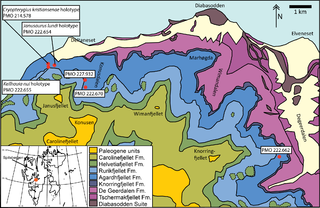
Ophthalmosaurus is an ichthyosaur of the Jurassic period. Possible remains from the Cretaceous, around 145 million years ago, are also known. Named for its extremely large eyes, it had a 6 metres (20 ft) long dolphin-shaped body with jaws containing many small but robust teeth. Major fossil finds of this genus have been recorded in Europe with a second species possibly being found in North America.
Plutoniosaurus is an extinct genus of ophthalmosaurid ichthyosaur from the Early Cretaceous of the vicinity of Ulyanovsk, European Russia.

Caypullisaurus is an extinct genus of large platypterygiine ophthalmosaurid ichthyosaur from the Late Jurassic to the Early Cretaceous of Argentina. Its holotype was collected from the Vaca Muerta Formation of Cerro Lotena, Neuquen, dating to the early Tithonian stage of the Late Jurassic, about 150 million years ago. Caypullisaurus was first named by Marta Fernández in 1997 and the type species is Caypullisaurus bonapartei.

Ophthalmosauridae is an extinct family of thunnosaur ichthyosaurs from the Middle Jurassic to the early Late Cretaceous worldwide. Almost all ichthyosaurs from the Middle Jurassic onwards belong to the family, until the extinction of ichthyosaurs in the early Late Cretaceous. Opthalmosaurids appeared worldwide during early Bajocian, subsequent to the disappearance of most other ichthyosaur lineages after the end of the Toarcian. Currently, the oldest known ophthalmosaurids is Mollesaurus from the early Bajocian of Argentina, as well as indeterminate remains of the same age from Luxembourg and Canada. Named by George H. Baur, in 1887, the family contains the basal taxa like Ophthalmosaurus. Appleby (1956) named the taxon Ophthalmosauria which was followed by some authors, but these two names are often treated as synonyms; Ophthalmosauridae has the priority over Ophthalmosauria. However, some researchers argue that Ophthalmosauridae should be restricted to the group typically referred to as Ophthalmosaurinae, with classic Platypterygiinae instead being referred to as Undorosauridae or Brachypterygiidae and Ophthalmosauria being used to unite these two groups.

Brachypterygius is an extinct genus of platypterygiine ophthalmosaurid ichthyosaur known from the Late Jurassic of England. The type species was originally described and named as Ichthyosaurus extremus by Boulenger in 1904. Brachypterygius was named by Huene in 1922 for the width and shortness of the forepaddle, and the type species is therefore Brachypterygius extremus. The holotype of B. extremus was originally thought to be from the Lias Group of Bath, United Kingdom, but other specimens suggest it more likely came from the Kimmeridgian Kimmeridge Clay of Kimmeridge Bay, Dorset, UK.

Undorosaurus is an extinct genus of ophthalmosaurid ichthyosaur known from western Russia, Svalbard, and Poland.
Mollesaurus is an extinct genus of large ophthalmosaurine ophthalmosaurid ichthyosaur known from northwestern Patagonia of Argentina.

Grendelius is a genus of platypterygiine ophthalmosaurid ichthyosaur from the Late Jurassic (Kimmeridgian-Tithonian) of the UK and European Russia.

Maiaspondylus is an extinct genus of platypterygiine ophthalmosaurid ichthyosaurs known from Northwest Territories of Canada, the Cambridge Greensand of England and the Voronezh Region of Russia.
Simbirskiasaurus is an extinct genus of ichthyosaur from the Early Cretaceous of Ulyanovsk Oblast, Russia. Its type specimen is YKM 65119, a fragmentary skull and vertebral column.

Arthropterygius is a widespread genus of ophthalmosaurid ichthyosaur which existed in Canada, Norway, Russia, and Argentina from the late Jurassic period and possibly to the earliest Cretaceous.

Athabascasaurus is an extinct genus of platypterygiine ophthalmosaurid ichthyosaur known from Alberta, Canada.
Sveltonectes is an extinct genus of platypterygiine ophthalmosaurid ichthyosaurs known from Ul’yanovsk region, western Russia.

Acamptonectes is a genus of ophthalmosaurid ichthyosaurs, a type of dolphin-like marine reptiles, that lived during the Early Cretaceous around 130 million years ago. The first specimen, a partial adult skeleton, was discovered in Speeton, England, in 1958, but was not formally described until 2012 by Valentin Fischer and colleagues. They also recognised a partial subadult skeleton belonging to the genus from Cremlingen, Germany, and specimens from other localities in England. The genus contains the single species Acamptonectes densus; the generic name means "rigid swimmer" and the specific name means "compact" or "tightly packed".

Sisteronia is an extinct genus of platypterygiine ophthalmosaurid ichthyosaur known from the 'middle' Cretaceous of southeastern England and southeastern France. It contains a single species, Sisteronia seeleyi.

The La Casita Formation is a geologic formation in Mexico. It preserves fossils dating back to the Kimmeridgian to lowermost Berriasian. It is laterally equivalent to the La Caja Formation and the Pimienta Formation. The ichthyosaurs Jabalisaurus and Acuetzpalin are known from the formation, as well as the metriorhynchid Dakosaurus and indeterminate pliosaurs.

The Agardhfjellet Formation is a geologic formation in Svalbard, Norway. It preserves fossils dating back to the Oxfordian to Berriasian stages, spanning the Late Jurassic-Early Cretaceous boundary. The formation contains the Slottsmøya Member, a highly fossiliferous unit (Lagerstätte) where many ichthyosaur and plesiosaur fossils have been found, as well as abundant and well preserved fossils of invertebrates.
Janusaurus is an extinct genus of ophthalmosaurid ichthyosaur from the Upper Jurassic Slottsmøya Member, Agardhfjellet Formation of Central Spitsbergen. The holotype consists of a partial skull. In 2019, Janusaurus was synonymized with Arthropterygius, though maintained as a separate species, by Nikolay Zverkov and Natalya Prilepskaya, although this synonymy was objected to later that same year by Lene Delsett and colleagues, who maintained that they were sufficiently different to warrant separate genera.
Gengasaurus is an extinct genus of ophthalmosaurid ichthyosaur from the Jurassic. The type and only species, Gengasaurus nicosiai, was named in 2017, after the locality of Genga, Marche. It lived in Italy about 152 million years ago and it was around 2.4 metres (7.9 ft) long when fully grown.



















